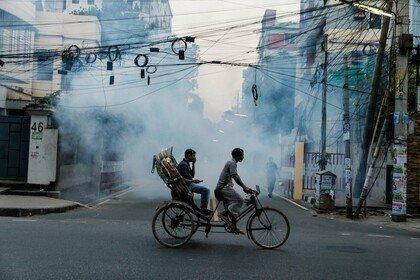
Summary
Schistosomiasis: symptoms, treatment and prevention
- Schistosomiasis is a parasitic disease caused by worms and transmitted through freshwater snails.
- There are two main types – intestinal and urogenital – which can cause chronic pain, bleeding and organ damage.
- 250 million people are affected globally, with 90% of cases in sub-Saharan Africa.
- Only one treatment is available for use – praziquantel – and there are concerns about emerging drug resistance.
- Climate change and land use changes are expanding the disease’s reach by altering snail habitats, water systems and human behaviour.
What is schistosomiasis?
Schistosomiasis is caused by parasitic worms of the genus Schistosoma.
The Schistosoma life cycle is complex. These worms live in freshwater snails and are released into water as larvae. When people or animals come into contact with infested water, the larvae can penetrate the skin and enter the bloodstream. They then travel to the organs where they mature and lay eggs. The eggs enter the urine and faeces of infected individuals, which can in turn contaminate freshwater sources with parasite eggs.
These eggs hatch into larvae that infect more freshwater snails. Inside the snail, the larvae develop and are released back into the water, ready to infect humans or animals again.
There are two major forms of the disease:
- intestinal schistosomiasis, which primarily affects the digestive system and liver
- urogenital schistosomiasis, which primarily affects the urinary and reproductive organs
Schistosomiasis symptoms vary depending on the type and stage of infection. Early symptoms may include rash, fever and muscle aches. As the disease progresses, it can cause chronic pain, diarrhoea, blood in urine or stool, and damage to the liver, kidneys, bladder and intestines.
Female genital schistosomiasis (FGS) affects an estimated 56 million women and girls. In addition to genital pain and bleeding, this form of the disease can lead to infertility, make contracting HIV more likely and may increase the risk of cervical cancer.
Who is most at risk from schistosomiasis?
The burden of schistosomiasis is not evenly distributed. It is most common in tropical and subtropical regions, particularly in sub-Saharan Africa, which accounts for 90% of the global burden.
Children are especially vulnerable due to frequent contact with rivers and lakes for bathing, swimming or collecting water. Women and girls who do household chores in contaminated water, and agricultural workers who irrigate fields, are also at high risk.
In some regions, environmental changes are making things worse as well.
Rising temperatures, shifting rainfall patterns and changes in land use are likely to alter the distribution of the parasitic worms and freshwater snails, as well as patterns of human exposure to contaminated water.
As the climate crisis accelerates, so too does the urgency to adapt our public health strategies.
Schistosomiasis doesn’t just harm health – it affects education, productivity and economic development. Women can face stigma associated with FGS. Children miss school and struggle to learn when they attend. Adults miss work. Communities are held back. Tackling the disease is not just a medical challenge – it’s a social and economic one too.
How is schistosomiasis diagnosed and treated?
Schistosomiasis diagnosis usually involves detecting parasite eggs in stool or urine samples. In some cases, blood tests or antigen detection methods are used to confirm infection.
There is currently only one drug available to treat schistosomiasis: praziquantel.
It’s effective at killing adult worms and is used in mass drug administration (MDA) programmes in high-prevalence areas. However, praziquantel doesn’t prevent reinfection, and there are growing concerns about the potential for drug resistance.
The World Health Organization recommends MDA when community prevalence exceeds 10%. [PDF] But determining prevalence accurately can be difficult, especially in remote or under-resourced areas. And while praziquantel is safe and affordable, supply is limited and access is uneven.
There is no available vaccine for schistosomiasis. So, in addition to providing praziquantel, control relies on a combination of:
- improved sanitation and hygiene
- access to clean water
- snail control
- veterinary public health
- environmental management
These strategies are effective but difficult to implement consistently in many endemic regions. Without sustained investment, progress is fragile.
What is Wellcome doing to combat schistosomiasis?
At Wellcome, we believe neglected tropical diseases like schistosomiasis demand urgent global attention. With the right tools, investment and global commitment, this is a disease we can control and ultimately eliminate.
That’s why we’re funding cutting-edge research to develop new interventions, from drug development programmes to a pioneering study in Uganda that’s accelerating vaccine progress through a safe and ethical human infection model.
We’re also closing critical knowledge gaps – supporting investigations into potential resistance to praziquantel in Africa, and using mathematical modelling to design cost-effective solutions.
Beyond funding, we’re bringing together experts across the sector [PDF] to identify further research priorities and tackle remaining evidence gaps.
Schistosomiasis is preventable and it’s treatable. And with the right investment, it’s possible to eliminate it as a public health problem. But that won’t happen without bold, inclusive and transformative action.
We’re funding research to better understand what causes and drives infectious diseases to escalate and the solutions to control their impact.
There are currently no open funding opportunities for Infectious Disease. Learn more about the funding we provide.


